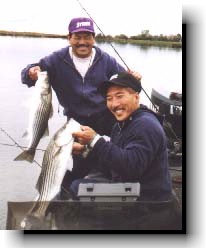|
Delta Stripers
 During
the fall months of the year the stripers start to move into the
delta system, which consists of over a thousand miles of waterways.
The stripers are on the move constantly chasing baitfish (shad) into
dead end sloughs, flooded islands and on weeded schouls. Stripers
will travel a long ways in one day feeding on shad, they will go
were ever they can trap the During
the fall months of the year the stripers start to move into the
delta system, which consists of over a thousand miles of waterways.
The stripers are on the move constantly chasing baitfish (shad) into
dead end sloughs, flooded islands and on weeded schouls. Stripers
will travel a long ways in one day feeding on shad, they will go
were ever they can trap the bait. The tides play a big part in finding the stripers day to day,
stripers use the currents to round up and trap the shad against
schouls and into flooded islands. I have found that on out going
tide from high to low is usually the best because the current goes
faster than on incoming tide. Look in the flooded islands and back
in the dead end sloughs on the high outgoing tide and on the
incoming tide the main San Joaquin river is the best. On a normal
winter with a normal amount of rain the stripers are easy to locate,
because the Sacramento river which feeds the delta gets dirtier than
the San Joaquin river. The stripers tend to stay in the central
delta systems along the San Joaquin river because it stays a lot
cleaner. During the fall the Delta will turn over and thats when it
gets real good, the water will turn real clear and cool off to
around 45-50 degrees. The stripers will feed real heavy for the next
three months until its time to head up the Sacramento River to begin
there spawning season. This time of year the stripers tend to be in
large schools consisting of hundreds of fish, mostly consisting of
school size. The larger stripers tend to be more loaners, but I have
found schools of fifteen pound fish in the flooded islands.
bait. The tides play a big part in finding the stripers day to day,
stripers use the currents to round up and trap the shad against
schouls and into flooded islands. I have found that on out going
tide from high to low is usually the best because the current goes
faster than on incoming tide. Look in the flooded islands and back
in the dead end sloughs on the high outgoing tide and on the
incoming tide the main San Joaquin river is the best. On a normal
winter with a normal amount of rain the stripers are easy to locate,
because the Sacramento river which feeds the delta gets dirtier than
the San Joaquin river. The stripers tend to stay in the central
delta systems along the San Joaquin river because it stays a lot
cleaner. During the fall the Delta will turn over and thats when it
gets real good, the water will turn real clear and cool off to
around 45-50 degrees. The stripers will feed real heavy for the next
three months until its time to head up the Sacramento River to begin
there spawning season. This time of year the stripers tend to be in
large schools consisting of hundreds of fish, mostly consisting of
school size. The larger stripers tend to be more loaners, but I have
found schools of fifteen pound fish in the flooded islands.
The use of a Delta map and good electronics will help you locate
stripers. Look for flooded islands, dead end sloughs and schouls
(sand bars) on the main river systems. On the San Joaquin river fish
the schouls in which the current flows into the island, the stripers
sit there waiting for the current to bring the bait fish to them.
Always look for Seagulls milling around in circles there usually
looking at the bait balls under the surface of the water, the gulls
will wait till the stripers start feeding forcing the shad to the
surface, then the gulls will also feed on the shad.
When the stripers trap the shad in the flooded islands
rattletraps, hair jigs, zara spooks and woodchopper lures work real
good. When fishing in the river I like to use hopkins, perk minnows,
gibbs minnows and duh spoons fishing them vertical, straight up and
down.
The rods, reels and line are very important when fishing any type
of lures. Graphite rods 6 Ĺ to 7 feet, medium to medium heavy
action will work best. 7ft glass rods with a medium heavy action
will work spoons better than a graphite rod, all the other baits
work better with graphite rods. Baitcasting reels that hold 125 yds.
of 15# line will work fine, spiderwire also works good. When
spooning heavy mono (25lb) test work the best because it hangs the
spoon up longer giving it a more natural dying shad look.
Each lure has itís own best presentation , rattletraps and hair
jigs reeled in fast with a pause over weed beds on the schouls will
get strikes. Top water baits fished when the stripers are chasing
shad to the surface, jerk the bait and then let it sit still, the
striper will hit when you move it again. Spoons work best when
fished vertical, you need to make sure your line is straight up and
down. Jerk up hard on the rod, pause then follow the spoon down, the
stripers always hit the spoon on the way down. You will feel a lite
tick on the way down, set the hook!
On a good day fishing on the Delta you can catch over fifty fish
a day!
|
|